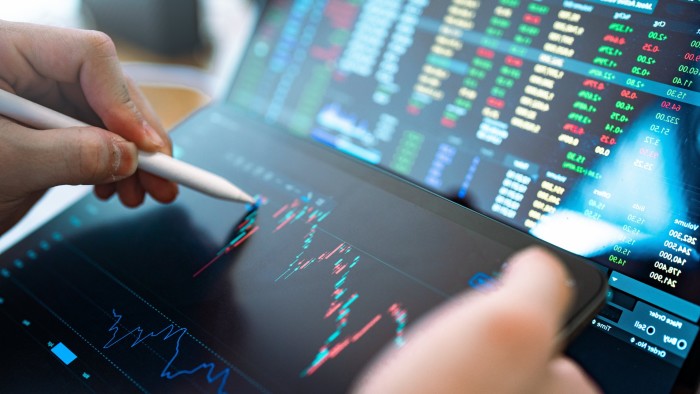AI-focused ETFs spread risk as fears grow of bubble

Simply sign up to the Capital markets myFT Digest -- delivered directly to your inbox.
Artificial intelligence represents one of the biggest technological advances ever, with a wide array of applications — from drawing pictures to driving cars. And asset managers have been quick to develop exchange traded funds that can capitalise on this potential.
But investors considering an allocation to these funds face a bewildering range of choices, including active and passive ETFs, concentrated and diversified portfolios, and strategies that give very different exposures to US tech giants versus their newer rivals.
Richard Dell, head of equity manager research at investment consultancy Mercer, says that, even though there is a strong consensus that AI will bring significant productivity improvements across multiple sectors, identifying the winning companies requires a long-term investment horizon.
“Investors must define what they want to achieve from their investment thesis and then take care to define the universe of companies,” he says.
WisdomTree, the US asset manager, has tried to help with this by splitting the sector into three categories: engagers, such as the software providers that have developed chatbots or robotic processes; enablers, such as Nvidia and other chipmakers, that make the hardware on which AI models are run; and enhancers, such as the Big Tech companies Microsoft, Alphabet, Apple and Amazon, that offer some AI services but do not yet derive the majority of their revenues from AI.
Already, though, some of the enhancers are designing their own AI chips and could pose more of a competitive threat in the future to Nvidia, the clearest winner so far in the AI revolution.
All three categories are combined in WisdomTree’s Artificial Intelligence Ucits ETF, with weightings of 50 per cent for engagers, 40 per cent for enablers and 10 per cent for enhancers.
“We are still in the process of discovering what AI users will demand, how to price it, and the revenues and profits that will be earned via AI,” says Christopher Gannatti, head of research at WisdomTree. “Some of the future winners from the AI megatrend will be surprises, which makes it important to have a diversified investment strategy.”
Excitement over the latest developments in generative AI, such as the ChatGPT chatbot, has led to a turnaround in sentiment among investors. Net global inflows into AI-branded ETFs have reached $3.1bn so far this year, compared with the net withdrawals of $649mn registered over the whole of 2022. The increase in inflows this year pushed total assets in AI-branded ETFs to $8.1bn at the end of September, according to ETFGI, a London-based consultancy.
However, some analysts warn that the current wave of investor enthusiasm for AI companies could create an unsustainable price bubble, similar to the one that developed in US tech companies in 1999. It eventually burst in March 2000, resulting in share price losses that took years to recover.
“We suspect that AI will have a similar impact on equities as the internet had during the second half of the 1990s, when the ‘dotcom bubble’ was inflating,” suggests Hubert de Barochez, an economist at Capital Economics.
JPMorgan notes that Nvidia, the leading provider of AI semiconductor chips, is currently trading on a price-to-earnings multiple of about 43 times, based on its forecast earnings for the financial year ending in January 2024.
High valuations for AI companies also trouble Mercer, the investment consultancy. It prefers to use active managers when allocating to thematic strategies, as human stockpickers have clearer views on potential winners and how much to pay for exposures. “It has been very challenging for passive funds to make money on a consistent basis when investing in a narrow theme,” cautions Dell.
Jay Jacobs, US head of thematics and active equity ETFs at BlackRock, says only a few megacap US tech stocks have so far won recognition from investors for their potential to profit from AI. This means the valuations for smaller and medium-sized competitors are less inflated, according to Jacobs. “Understanding the full scope of the AI universe is difficult,” he says. “AI is a very broad theme with lots of potential winners.”
That view led BlackRock to give an equal weighting to all of the 113 constituents of the $464mn iShares Robotics and Artificial Intelligence Multisector ETF, known as IRBO. In contrast, most ETFs weight their constituents by market value, giving more prominence to larger companies.
The equal weighting used by IRBO has the effect of reducing the valuation of the fund as a whole, which trades on a historic price-to-earnings multiple of 21 times, slightly below the 21.8 times multiple for the broader S&P 500 index.
Even so, Rob Arnott, founder and chair of the investment adviser Research Affiliates, advises caution. He believes that the customers of AI businesses, rather than the providers of AI technology, will be the main beneficiaries of this innovation. “While some AI stocks may exceed the extraordinary success priced into their shares, history teaches most will fail to do so,” he warns.
Comments